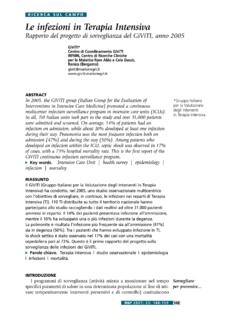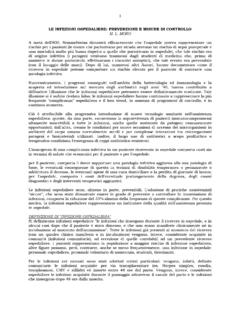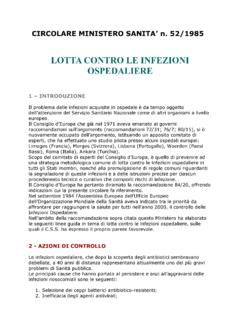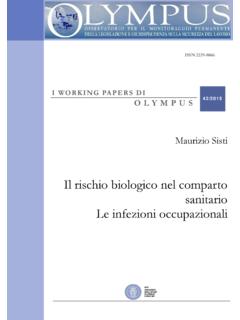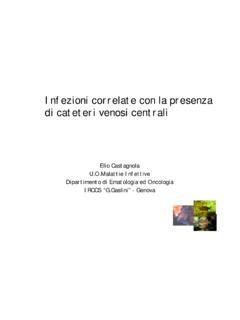Transcription of Chapter 7.1 Nitrogen dioxide - WHO/Europe | Home
1 Chapter Nitrogen dioxide General description Many chemical species of Nitrogen oxides (NOx) exist, but the air pollutant species of most interest from the point of view of human health is Nitrogen dioxide (NO2). Nitrogen dioxide is soluble in water, reddish-brown in colour, and a strong oxidant. Nitrogen dioxide is an important atmospheric trace gas, not only because of its health effects but also because (a) it absorbs visible solar radiation and contributes to impaired atmospheric visibility; (b) as an absorber of visible radiation it could have a potential direct role in global climate change if its concentrations were to become high enough.
2 (c) it is, along with nitric oxide (NO), a chief regulator of the oxidizing capacity of the free troposphere by controlling the build-up and fate of radical species, including hydroxyl radicals; and (d) it plays a critical role in determining ozone (O3) concentrations in the troposphere because the photolysis of Nitrogen dioxide is the only key initiator of the photochemical formation of ozone, whether in polluted or unpolluted atmospheres (1, 2). Sources On a global scale, emissions of Nitrogen oxides from natural sources far outweigh those generated by human activities.
3 Natural sources include intrusion of stratospheric Nitrogen oxides, bacterial and volcanic action, and lightning. Because natural emissions are distributed over the entire surface of the earth, however, the resulting background atmospheric concentrations are very small. The major source of anthropogenic emissions of Nitrogen oxides into the atmosphere is the combustion of fossil fuels in stationary sources (heating, power generation) and in motor vehicles (internal combustion engines). In most ambient situations, nitric oxide is emitted and transformed into Nitrogen dioxide in the atmosphere.
4 Oxidation of nitric oxide by atmospheric oxidants such as ozone occurs rapidly, even at the low levels of reactants present in the atmosphere. Altshuller (3) calculated that 50% conversion of nitric oxide would take less than 1 minute at a nitric oxide concentration of 120 g/m3 ( ppm) in the presence of an ozone concentration of 200 g/m3 ( ppm). Consequently, this reaction is regarded as the most important route for Nitrogen dioxide production in the atmosphere. Other contributions of Nitrogen dioxide to the atmosphere come from specific noncombustion industrial processes, such as the manufacture of nitric acid, the use of explosives and welding.
5 Indoor sources include tobacco smoking and the use of gas-fired appliances and oil stoves. Differences in the Nitrogen oxide (nitric oxide and Nitrogen dioxide ) emissions of various countries are due mainly to differences in the consumption of fossil fuels. Worldwide emissions of Nitrogen oxides in the early 1980s were estimated at approximately 150 1012 g/year (1). Occurrence in air Maximum 30-minute or 1-hour average and maximum 24-hour average outdoor Nitrogen dioxide concentrations of up to 940 g/m3 ( ppm) and 400 g/m3 ( ppm), respectively, have been reported.
6 Annual mean concentrations in urban areas throughout the world are generally in the range Chapter Nitrogen dioxide Air Quality Guidelines - Second Edition WHO Regional Office for Europe, Copenhagen, Denmark, 2000 2 20 90 g/m3 ( ppm) (1, 4 6). Urban outdoor levels vary according to the time of day, the season of the year and meteorological factors. Typical daily patterns comprise a low background level on which are superimposed one or two peaks of higher levels that correspond to rush-hour traffic emissions of Nitrogen oxides. Hourly average Nitrogen dioxide concentrations near very busy roads often exceed 940 g/m3 ( ppm) (7).
7 Maximum hourly concentrations in the United Kingdom are generally of the order of 470 750 g/m3 ( ppm) (5). From 1988 to 1990, highest 1-hour averages in the United States ranged from 75 to 1015 g/m3 ( ppm) (1). Thus, the maximal hourly mean value may be several times the annual mean (1, 8). Long-term monitoring activities during the 1960s and 1970s indicated an increase in concentrations of Nitrogen oxides in many urban areas throughout the world (9, 10). Recent reports from the United States, however, show a decrease in nationwide Nitrogen dioxide concentrations, resulting from a decrease in Nitrogen oxides emissions, from 1981 to 1990 (1).
8 Whether Nitrogen dioxide concentrations are increasing in urban areas in other parts of the world is unknown, although it is known that, at least in the United States, concentrations are highly correlated with population level (1) and population levels worldwide continue to grow. Nevertheless, indoor sources, such as cooking with gas or cigarette smoking, may be the main contributors to individual exposure. Owing to the widespread use of unvented combustion appliances, Nitrogen dioxide concentrations in homes may exceed considerably those found outdoors (1, 11).
9 The average concentration over a period of several days may exceed 200 g/m3 ( ppm) when unvented gas stoves are used for supplementary heating or clothes drying, or when kerosene heaters are used; typically, means are lower (1, 12 14). Maximum brief (minutes to 1-hour) concentrations in kitchens are in the range 230 2055 g/m3 ( ppm) during cooking (15, 16). The highest 15-minute concentration recorded for a home with an unvented gas space heater was 2716 g/m3 ( ppm) (17). Conversion factors Nitrogen dioxide : l ppm NO2 = 1880 g/m3 l g/m3 NO2 = 10-4 ppm Nitric oxide: 1 ppm NO = 1230 g/m3 1 g/m3 NO = 10-4 ppm Routes of exposure In the environment, Nitrogen dioxide exists as a gas.
10 Thus, the only relevant route of exposure to humans is inhalation, whether the source is outdoor air or indoor air. Occupational exposure is limited to a few industrial processes and includes a wide variety of exposures. Occupational exposures are relatively rare compared to outdoor and domestic exposures. Toxicokinetics Owing, in part, to the high degree of scientific difficulties involved, very little research on the kinetics and metabolism of Nitrogen dioxide has been conducted. The available information is very limited and only partially describes its deposition and fate in the respiratory tract.










